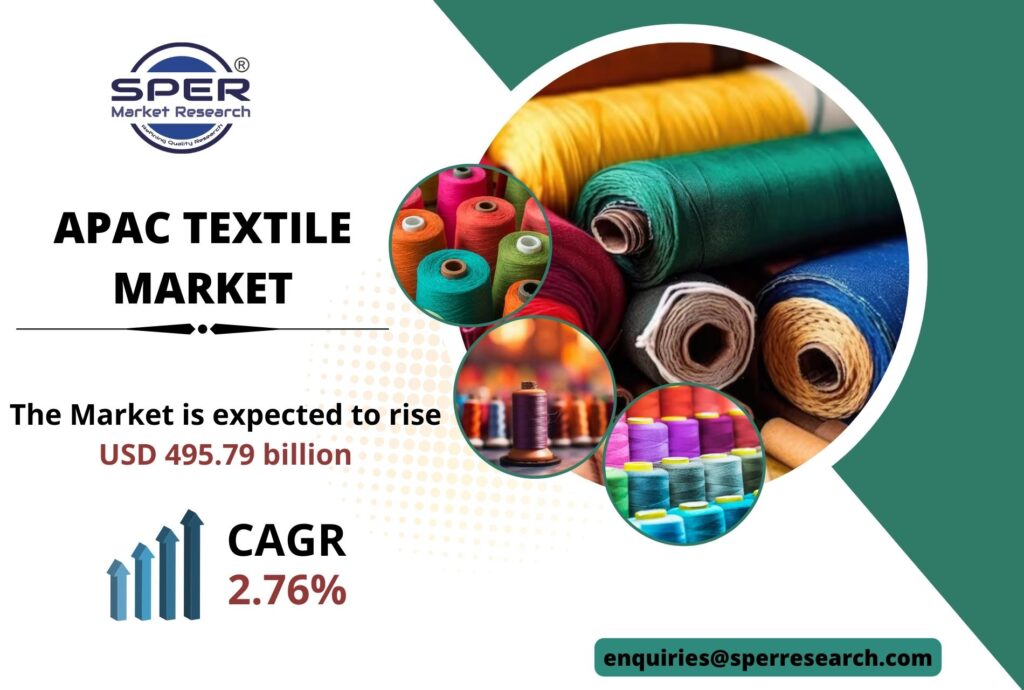Asia Textile Market Growth 2023, Share, Emerging Trends, CAGR Status, Revenue, Demand, Business Opportunities and Future Outlook 2033: SPER Market Research

The textile sector focuses on creating, manufacturing, and distributing textiles, which encompass materials like yarn, fabric, and apparel. These materials can originate from either natural sources or be synthetically produced using chemical industry derivatives.
According to SPER market research, ‘Asia Textile Market Size– By Material, By Application- Regional Outlook, Competitive Strategies and Segment Forecast to 2033’ state that the Asia Textile Market is predicted to reach USD 495.79 billion by 2033 with a CAGR of 2.76%.
A shift in consumer preferences towards affordable and comfortable clothing is driving the demand for high-quality fabrics like viscose, silk, and hemp. Blended fiber varieties, combining artificial and natural yarn, are also experiencing significant growth, creating new market opportunities in the future. Polyester and cotton are widely utilized textile yarn products in the Asia-Pacific region. Factors such as shifting consumption patterns, population growth, rising disposable incomes, and increased demand for clothing and home furnishing products are key drivers of this growth. Moreover, there is a growing demand for home textiles in the APAC region. Home textiles encompass items like blankets, bed linens, tablecloths, cleaning and kitchen cloths, curtains, bedcovers, sheer curtains, wall carpets, sleeping bags, terry towels, mattresses, quilts, pillows, tapestries, and more. These products find applications in residential spaces, hotels, offices, and other settings within the interiors.
However, Asia’s textile market is highly competitive, with numerous companies vying for market share, potentially leading to price wars and margin pressures. Additionally, the presence of unregulated industrial waste is a key driver behind the proliferation of laws and regulations governing textile production. This issue is particularly pronounced in developing nations that are in the midst of industrialization. The accumulation of mismanaged industrial waste, which can harm the surrounding environment, stands as a significant impediment to the industry’s expansion.
Request For Free Sample Report @ https://www.sperresearch.com/report-store/asia-textile-market.aspx?sample=1
Additionally, the textile industry has faced substantial challenges and hardships due to the COVID-19 crisis, impacting brands, manufacturers, and workers across different aspects. This pandemic has revealed vulnerabilities within garment supply chains and the repercussions that sourcing decisions can have on supplier factories and their labour force. Asia, where a significant portion of global garment production is located, continues to experience the primary impacts of these disruptions in the supply chain.
Geographically, China held the leading position as the world’s top textile exporter, encompassing both the materials used in clothing manufacturing and the finished garments. Following China, Bangladesh secured the second spot in global textile exports. Additionally, some of the market key players are Arvind Ltd, Bombay Dyeing and Manufacturing Company Ltd, Bombay Rayon Fashions Ltd, Cotton Corporation of India, Others.
For More Information, refer to below link: –
Asia Pacific Textile Industry Forecast
Related Reports:
Follow Us –
LinkedIn | Instagram | Facebook | Twitter
Contact Us:
Sara Lopes, Business Consultant — USA
SPER Market Research
+1–347–460–2899





